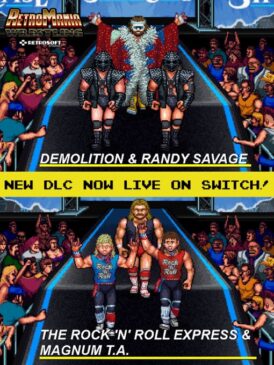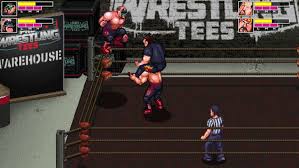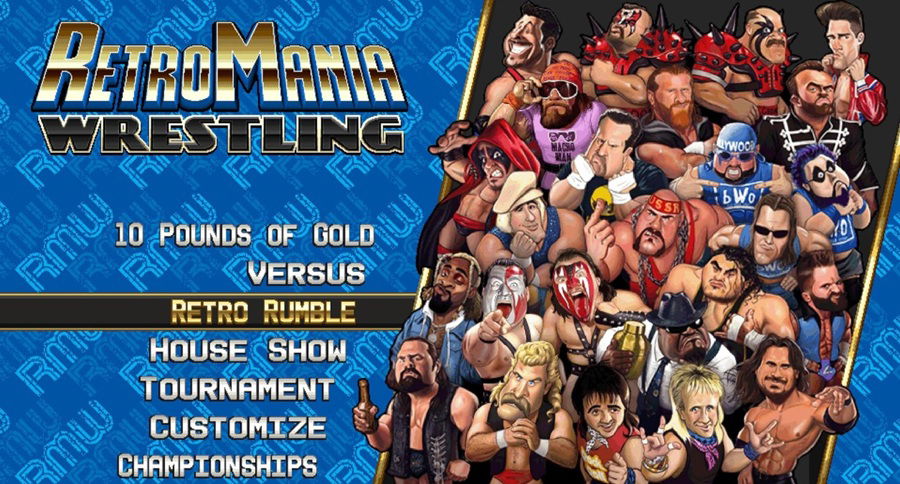When it comes to wrestling and video games, the pickings are usually slim whether you’re playing on console or PC. Regardless of your platform, chances are if you watched wrestling at some point you’ve booted up a digital grappler to test your mettle against your friends and pretty commonly an overbearing CPU testing the limits of being “the dirtiest player” in the game.
WWE still owns the market regardless of AEW’s serviceable Fight Forever release in 2023. Although AEW’s effort was good, it still left much to be desired in a space where WWE is king, and Spike Chunsoft’s Fire Pro Wrestling World (2017/2018) is technically-speaking one of the better designed games out there. You can still play FPWW on Steam in case you’ve since parted with your PlayStation 4.
Sprinkled around those tentpole releases, especially now when it’s so easy to get your games out into the public, are indie games like Wrestling Empire, WrestleQuest, or any of the retro grapplers Hamster games has been re-releasing such as 3 Count Bout, Champion Wrestler or Mat Mania.
The latter of those three older games — Mat Mania — is interesting as it’s the precursor for what became the beloved WWF game WrestleFest, which later inspired the development and 2021 release of RetroMania wrestling by RetroSoft Studios.
For those who might not recall WWF WrestleFest, it was a 1991 arcade wrestling game that featured two core game modes:
- Royal Rumble
- Saturday Night’s Main Event (story mode)
That is nothing by today’s standards, but the story mode is mostly what this game is remembered for outside of its solid gameplay. Without getting into the complete roster, it featured stars of the day including Hulk Hogan, Ultimate Warrior, Mr. Perfect, Jake Roberts, Ted Dibiase, Demolition (Smash and Crush), and the Road Warriors as NPC bosses in the tag team-centric story mode. In that game you would chose two wrestlers (I usually went with either Demolition, or a combination of Warrior, Earthquake and Mr. Perfect), and you would wrestle a series of teams for the chance to fight Hawk and Animal for the tag team titles.
I only ever had the chance to play WrestleFest a handful of times, but it’s one of my favourite wrestling games to this day. That game had a tremendous impact on how games evolved — it was certainly the first game I played that really let you go outside the ring, use chairs, ring steps, and otherwise cause havoc at ringside. Because of the imprint that game made on wrestling gaming fans, it spawned the idea to revive the Technos Japan-created engine in RetroMania Wrestling.
The Base Game
I reviewed the original version of the game when it was released in 2021. On release the game was packaged with 16 wrestlers and was later expanded to 19 following a series of free DLC additions to the roster. That roster was composed of:
- Road Warriors (Hawk and Animal)
- Johnny Retro (John Morrison/Johnny Nitro/Johnny TV, etc.)
- Nick Aldis (NWA Champion)
- Zack Sabre Jr.
- Brian Myers
- Matt Cardona
- Nikita Koloff
- the bWo (Stevie Richards, Blue Meanie, Hollywood Nova)
- Tommy Dreamer
- Jeff Cobb
- Austin Idol
- Colt Cabana
- Warhorse
- Mr. Hughes
- James Storm
- Chris Bey
It addition to showcasing a number of wrestlers from many different promotions, the game also featured a collection of wrestling arenas. The collection spanned licensed NWA-themed arenas, venues inspired by real locations (Hammerstein and Korakuen Hall), a variety of retro game conventions, Pro Wrestling Tees-themed warehouse locations, and bWo-themed arenas.
As we know though the heart of any game are the modes. RetroMania launched with four core modes, including a story mode (that was expanded in a 2024 update) in which you controlled Johnny Retro through a single player story as he navigates his personal comeback trail, a 10 Pounds of Gold mode in which the objective is to wrestle a series of matches to earn a shot at NWA champion Nick Aldis (and then defend it), a Retro Rumble mode, and the straight-forward Versus mode.
In Versus you can choose any of the available roster members, and then edit the match rules to whatever you desire. Match options and rule edits include:
- Singles
- 3-Way Dance/4-Way Dance
- Tag Team
- Trios
- 8-Man Tag
- Variety of Handicap matches
- Time Limit (5, 10, 15 and no time limit options)
- Steel Cage (choose between classic blue-barred ’80s era steel cage or chain link)
- Falls Count Anywhere
- Best 2 of 3 Falls
- Ring Counts (10, 20, 30 seconds, or no count out)
- AI Battle (have CPU opponents battle)
- Music selection (choose between 8 original songs to play, or randomize them)
So, How Does It Play?
Gameplay is always going to make or break a wrestling game no matter how good it does or doesn’t sound on paper.
The engine is built off the same premise as WrestleFest as an Arcade-style, fast-paced pick-up-and-play format, with the execution of strikes and moves hinging on a momentum meter you can build up over time. You can either build it up the hard way by executing three stages of moves broken down between light, medium and strong grapple attacks. You’ll need to execute each level of attacks to build up your meter into the second part of the meter in order to do your more damaging attacks.
Once you’ve done the same in the final third of your momentum bar, your bar will start flashing. Alternatively, you can just cheese the system and taunt until your meter flashes. Either way, that means you can execute your grappler’s finisher. It’s really not unlike similar games released around 1998-2000 for the N64 and original PlayStation where moves were based on a similar “Spirit Meter.”
On the moves front, each wrestler has their own hand-animated movesets with many of the roster members having their own signature moves. Each move is executed cleanly in all of the games’ old school pixeled glory. In addition to all of the individual moves, there are a number of tag team moves in the game, such as the Road Warriors’ Doomsday Device.
Core Gameplay
With the moves outlined, this is where you’ll decide whether or not this is a wrestling game you’ll want to try.
The game engine is dissimilar from what you’ll find in either the 2K or AEW Fight Forever games, and is more akin to Fire Pro Wrestling or those older WWF and WCW games from the N64/PS1 era. I think it’s much closer to how Fire Pro plays in that the moves are more or less triggered by accident upon your character and your opponent walking into each other.
An animation is triggered and you as the player need to time a button press to execute your move from within the grapple. Either will execute your move, say a body slam, or you and your opponent will struggle and you’ll need to button mash to regain priority. It sounds awkward and removes a little agency if you’re used to the more streamlined 2K style, but if you’re familiar with how Fire Pro plays you should be able to pick up the timing off the foot stomps of the two wrestlers’ lead feet as they grapple. It sounds weird, but that’s the best way to describe how to play it; I’ve seen it turn people off of games like Fire Pro.
Once you have the moves down, the match is up to you. Once you grapple you have access to multiple moves per strength type (light, medium, strong) based on directional button presses, you can irish whip opponents wherever you like, perform moves in the turnbuckle, top rope or hit the ground for the submission game, or if you’re feeling like channeling Dreamer, hit the floor and grab a chair.
Outside the ring, you can go into the options menu to edit or view a selection of gameplay settings, notably audio, controls, difficulty level, walk speed, second wind, momentum handicaps, and match length (affects speed momentum fills and damage output).
Generally speaking as someone who had history with WrestleFest, and who was already playing Fire Pro World for 2-3 years before this game’s original release, picking up RetroMania’s grapple system was pretty easy, but otherwise you might need time with it or similar games to get the hang of it. The core game does goes on sale frequently on all platforms, and its file size is not particularly large, coming in at about 1.2 GB on Switch/Switch 2. It is currently $19.99USD on Steam.

Legends DLC Update (2025)
From the outset the small development team promised they would keep content coming, and they did that with their trio of free DLC characters (Bey, Hughes and Storm). Now a few years after release and several small patches that have improved gameplay, tweaked animations and added new moves, the team released its Legends update in September 2025 that adds six new characters, new stages, and a collection of new modes and customization options.
Roster Additions
In what I can only surmise was accomplished through dark magicks (or more likely contract lapses?), the Legends update added more value to a fun, eclectic roster that already featured a tapestry of wrestlers you probably would never see in a ring together. These legends were recently added:
- Rock ‘n Roll Express (Ricky Morton and Robert Gibson)
- Magnum TA
- Demolition (Ax and Smash)
- “Macho Man” Randy Savage
The first three don’t seem too ridiculous since they are not WWE 2K mainstays, but some degree of contract lapses or IP rights lapsing occurred that has allowed Demolition to appear in a non-WWE game (only their third game appearance ever — WrestleFest and WWE 2K12), and Savage who also appears in WrestleQuest.
I have yet to use Magnum, Morton or Gibson, but from playing Savage and Demolition I can confirm they have their own unique moves, finishers and animations that make them stand out a part from the other inclusions. For example, Demolition has their finisher, overhead grounded smash attacks, etc., while Savage has his elbow drop, standing elbow strikes, punching combinations and knee attacks to the opponent’s back. It adds authenticity to the characters and aren’t just palette or moveset style copies from other wrestlers in the game.
If you’re already playing the game, the $9.99 CAD price is worth it (converts to about $7 USD) as it adds six legends to bolster the roster, and three of which I’m frankly still shocked the team got the rights to include.
The update also carries with it the ability to customize a wrestler’s ring attire by changing the colour of several pieces of ring wear including two “cap” colours, wrist colours (tape, gloves etc.), kneepads, two boot colours, intro mask colours and four different gear options that can also have specific colours added. You can have up to 10 edits and choose whichever you prefer for matches. For example, Savage is wearing his WrestleMania 5 gear by default, and if you wanted to you could colour swap his gear to mimic gear from WrestleMania 2 through 4.
New Modes
In addition to the modes from the core game, RetroSoft Studios has added:
- House Show mode
- Tournament Mode
- Two new championships (RetroMania Championship and the tag team championships) since launch
In tournament mode you have the option to choose between a singles run or a tag team run. Both modes allow you to edit the same rules set as the rest of the game, including whether or not you want to have 4, 8 or 16 wrestler tournaments in singles, or four and eight teams in tag team mode.
Tournament mode gives you access to promoter mode where you can set up a standard tournament in either singles or tag team formats. Alternatively you can choose Arcade mode and enter either the “King’s Cup” or “The Tag Team Classic.”
The King’s Cup allows you to choose one wrestler from the roster to enter the tournament. You have the option to either watch all of the CPU battles, or simulate them if all you want to do is play your own matches. Each Cup has its own difficulty level ranging from Bronze to Gold league. Your progression will be tracked in the high score listing, although it doesn’t seem to track globally online. Similarly so the tag team classic tournament allows you to choose two wrestlers and go up against (up to) seven other teams and complete more or less the same tasks.
House Show mode is the highlight of the update as it allows you to either compete to earn a high score in preset matches, or book your own card of four matches, apply your own win conditions, and most importantly defend the game’s three championships (in addition to being able to in Versus mode). It’s a quick and easy setup and while not as involved and dense as you’d expect from WWE or as the micro management centric Fire Pro Wrestling World’s promoter mode, it fits with RetroMania’s arcade-centric, pick-up-and-play style and is a great addition to the game mode options.

Final Thoughts
I preordered a code from the game’s original run for the OG Nintendo Switch and it’s a purchase I never regretted. Where that console had few options for wrestling games at the time aside from old Hamster ports, SNK games, ones on Nintendo retro apps and the abomination that was WWE 2K18 (although side note, APPARENTLY it’s less of an abomination on Switch 2). It filled a hole, and was doubly exciting because of its lineage and connection to an arcade game I loved in WrestleFest, as well as that arcade unit’s precursor WWF Superstars.
The core gameplay is a modernized update of that system that borrows the best parts of it and melds it together with Fire Pro Wrestling to create something unique for modern wrestling gamers looking for companion games to the more obvious purchases like WWE 2K, or even AEW and Fire Pro. While those games are aesthetically more polished, the heart of RetroMania leans on the nostalgia factor with its music, graphics, and lovingly crafted game that is 100% an independent effort from the RetroSoft team.
The game has been improved through several updates since launch, and with the new modes, once you go into “10 Pounds of Gold” once there’s really no need to ever go back. There are enough options to keep you playing once you immerse yourself in the game, and with what has been added since launch it’s as though it’s a whole new game.
The complete roster is a great combination of wrestling legends and modern indie standouts, combined with young wrestlers like Chris Bey and Warhorse. Part of its charm is its eclecticness from including wrestlers that are rare to see in wrestling games outside of maybe those old “Legends of Wrestling” games, and meshing them together with contemporary and younger wrestlers to give you what amounts to a fun package whose roster covers wrestling history featuring NWA, WWF, modern WWE, TNA, NJPW, ROH/AEW talents, and whatever company you want “Johnny Retro” to be from.
The stages are all unique from each other and have their own charm as the backdrop for the matches. It’s a tremendous amount value for the price and level of care that has gone into this passion project that I have been playing again consistently since its launch last month. Essentially, since the update if I’m not grinding ranks in Street Fighter 6 or running around Fortnite, I’m playing RetroMania. I’ve always enjoyed setting up cards, and having the ability to use a number of wrestlers I enjoy watching now, combined with legends like Savage, Demolition, Road Warriors, Tommy Dreamer or the forever chameleon Johnny _____, makes it a hard game to take a pass on.
It will never be on the scale of WWE games, but there’s a lot under RetroMania’s hood. The team’s commitment to continue to improve and build on the game year-over-year makes it a worthwhile game to play and invest in as a companion to bigger budget titles. It’s a solid 8/10 game with plenty of room to grow as they continue to add more content, and the price of both the core game and DLC are a drop in the bucket compared to what WWE and AEW games and their extra content are priced at.
So if you ever wanted to run back Demolition and the Road Warriors and have the winner play the Rock ‘n Roll Express, or wanted to see what Zack Sabre Jr. could do against Randy Savage, now is as good a time as any to give the game a shot and find out.
